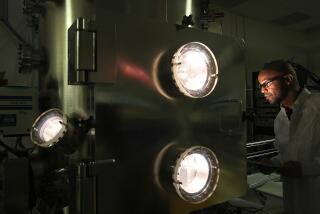Lockheed and AeroVironment sign agreement on drone development
Defense giant Lockheed Martin Corp. signed an agreement with Monrovia drone maker AeroVironment Inc. to pursue opportunities together in unmanned aircraft development.
The deal was announced late Thursday at the Defense Expo in India and centered on jointly working on AeroVironment’s massive robotic Global Observer aircraft. The companies are looking to sell the high-flying drone overseas.
With a wingspan of 175 feet, the aircraft is built to stay aloft for a week at a time at 65,000 feet -- vastly expanding the reach of military spy planes.
The primary focus of the agreement is to integrate Lockheed’s mission systems, ground systems and technology with AeroVironment’s aircraft.
“At Lockheed Martin, we look forward to partnering with AeroVironment to potentially develop integrated solutions for the unmanned systems market,” Paul Lemmo, Lockheed’s senior vice president of corporate strategy and business development, said in a statement. “Using our expertise in systems integration and AeroVironment’s knowledge of unmanned aircraft solutions, we will together look for opportunities to develop innovative technologies that create value for new and existing customers.”
Lockheed is the world’s largest defense contractor. AeroVironment is the Pentagon’s top supplier of small hand-launched drones -- including the Raven, Wasp and Puma models -- that give troops on the ground a bird’s-eye view of what’s happening over a ridge or around a bend.
The Global Observer is a departure from those small drones. The large drone is designed to do work that so far has been done by satellites, including relaying communications between military units and spotting missiles as they are launched.
It’s able to fly for a week because it has an internal combustion engine that burns cryogenically stored liquid hydrogen. The engine powers a generator that produces electricity, which turns the plane’s four propellers affixed to its fixed wing.
Because of the Global Observer’s hydrogen fuel source, its exhaust is water vapor.
AeroVironment built two Global Observers. The first one was lost when it crashed at Edwards Air Force Base in an April 2011 test flight.
The company believes there is an international market for the technology.
“Numerous customers are seeking persistent solutions for wide area applications, such as border surveillance and communications, that are much more affordable than those available previously,” Roy Minson, an AeroVironment senior vice president and general manager, said in a statement.
The deal could be beneficial because both companies depend largely on funding from the Pentagon, which is winding down its presence in the Middle East and preparing for budget cuts. AeroVironment’s revenue has dropped four quarters in a row.
“Lockheed Martin’s broad systems integration expertise gives us the opportunity to work together and develop innovative, end-to-end atmospheric satellite systems built around Global Observer that deliver breakthrough capabilities to customers,” Minson said.
In trading Friday, AeroVironment shares climbed $1.80, or 6.4%, to $29.72. Lockheed shares rose $3.39, or 2.2%, to $155.13
ALSO:
Boeing to produce its 737 jet at highest rate ever
Top secret British combat drone ‘Taranis’ makes first flight
Engineer accused of trying to send F-35 fighter jet papers to Iran







